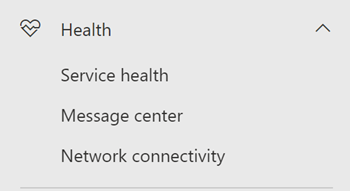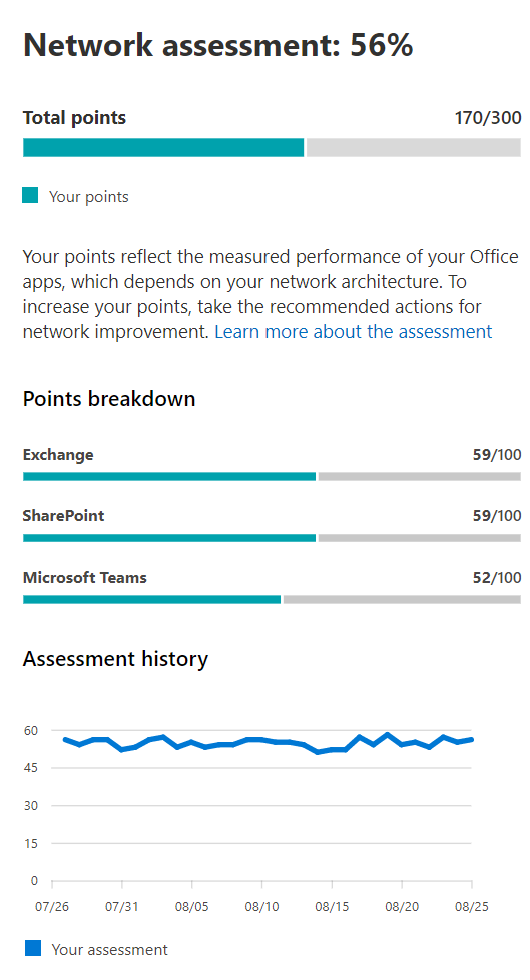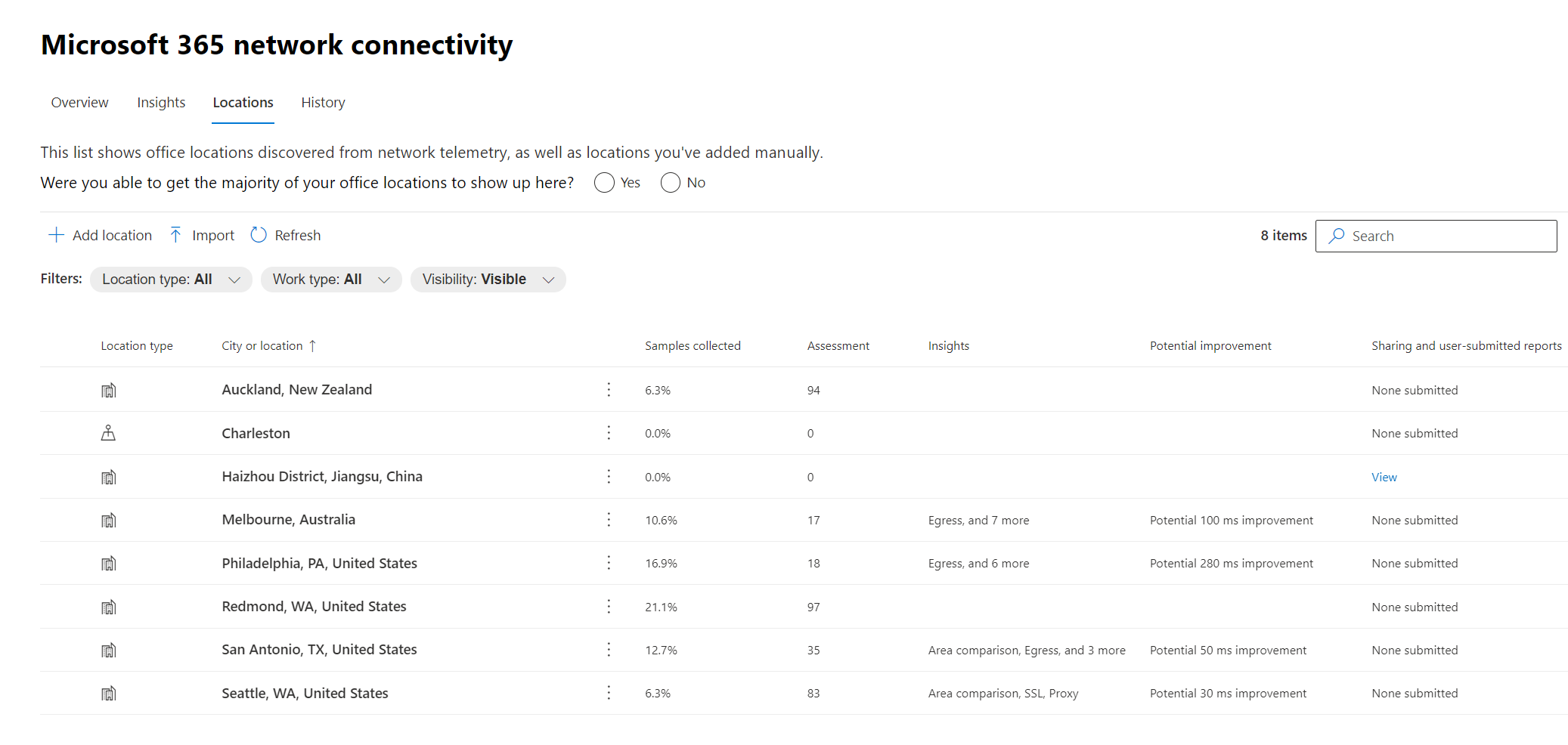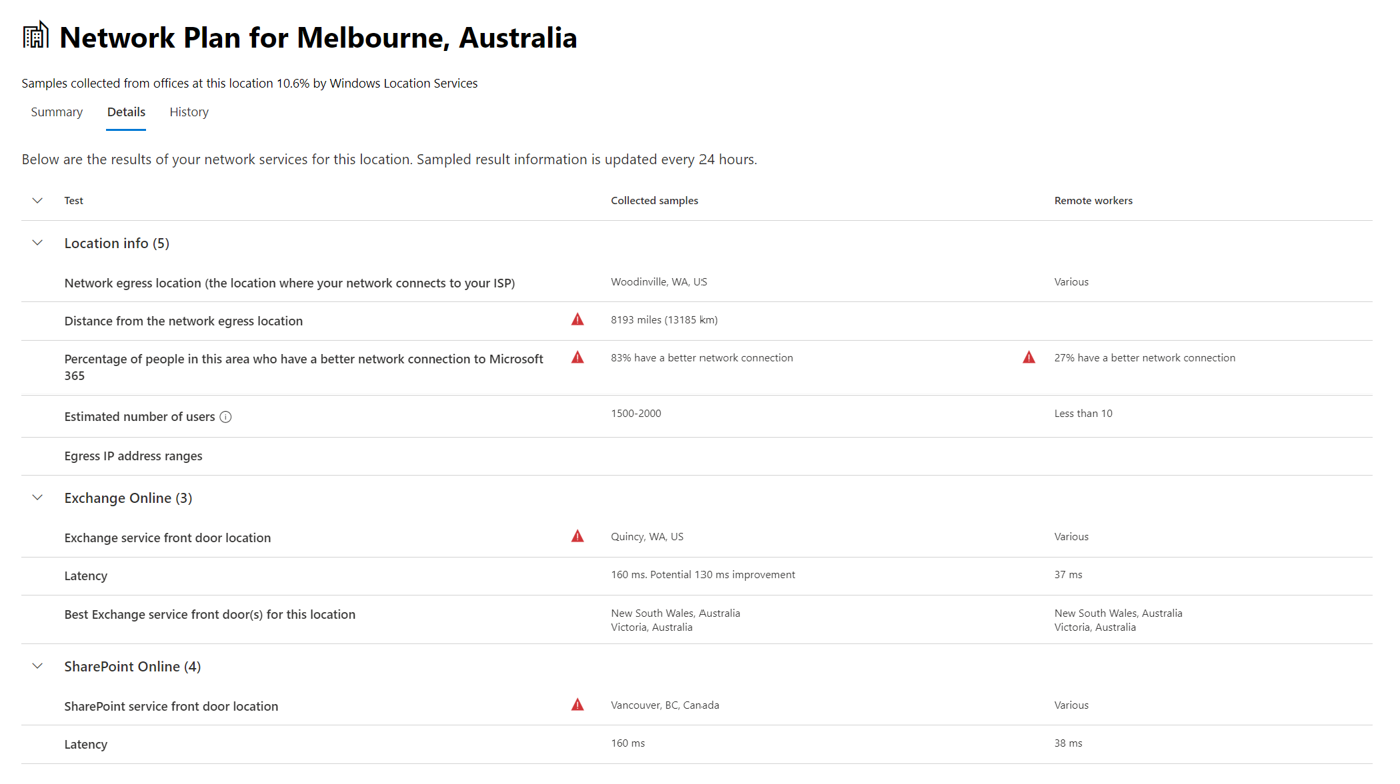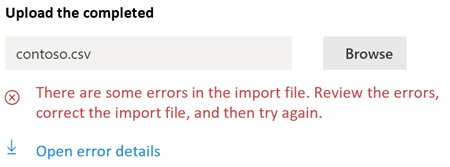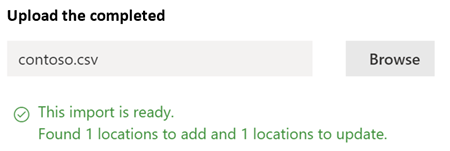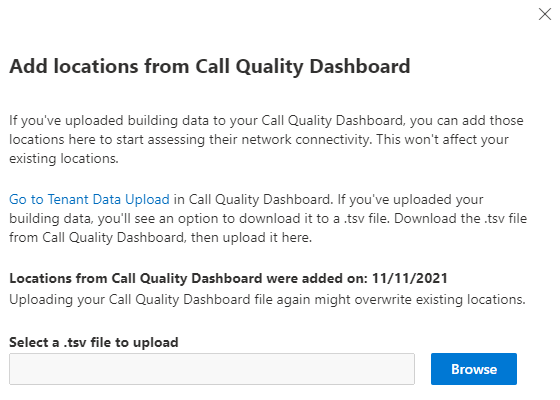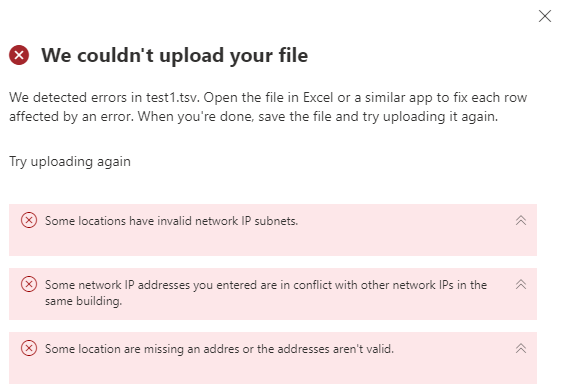The Microsoft 365 Admin Center now includes aggregated network connectivity metrics collected from your Microsoft 365 tenant and available to view only by administrative users in your tenant.
Network assessments and network insights are displayed in the Microsoft 365 Admin Center under Health | Network connectivity.
Note
Network connectivity in the Admin Center supports tenants in WW Commercial and China (Operated by 21Vianet, released on 2024-09-23), but not GCC Moderate, GCC High, or DoD.
When you first navigate to the network performance page, you have to configure your locations in order to see the map of global network performance, a network assessment scoped to the entire tenant, percentage of your users working remotely vs onsite, and a list of current issues to take action on and/or to research further. From the overview pane, you can drill down to view specific network performance metrics and issues by location. For more information, see Network performance overview in the Microsoft 365 Admin Center.
To access the network connectivity page, you must be an administrator for the organization within Microsoft 365. The Report Reader administrative role will have read access to this information. To configure locations and other elements of network connectivity an administrator must have the Service Support Administrator role.
Prerequisites for network connectivity assessments to appear
To get started, turn on your location opt-in setting to automatically collect data from devices using Windows Location Services, go to your Locations list to add or upload location data, or run the Microsoft 365 network connectivity test from your office locations. These three options for office location information are detailed below. While network connectivity can be evaluated across the organization, any network design improvements need to be done for specific office locations. Network connectivity information is provided for each office location once those locations can be determined. There are three options for getting network assessments from your office locations:
1. Enable Windows Location Services
For this option, you must have at least two computers running at each office location that support the prerequisites. OneDrive for Windows version must be up-to-date and installed on each computer. Network tests are only run no more than once a day at a random time. Network measurements will be added to other Microsoft 365 client applications soon.
Windows Location Service must be consented on the machines. You can test this by running the Maps app and locating yourself. It can be enabled on a single machine with Settings | Privacy | Location where the setting Allow apps to access your location must be enabled. Windows Location Services consent can be deployed to PCs using MDM or Group Policy with the setting LetAppsAccessLocation.
You don't need to add locations in the Admin Center with this method as they're automatically identified at the city resolution. Multiple office locations within the same city won't be shown when using Windows Location Services. Location information is rounded to the nearest 300 meters by 300 meters so that more precise location information isn't accessed. Use of Windows Location Services for network measurements is off by default for customers. You must enable it in the Network Connectivity Settings Location flyout.
The machines should have Wi-Fi networking rather than an ethernet cable. Machines with an ethernet cable don't have accurate location information.
Measurement samples and office locations should start to appear 24 hours after these prerequisites have been met. Office locations discovered from Windows Location Services are aggregated per City and are retained in your view for 90 days after samples are no longer received. If you choose to switch to office locations added by the Administrator with LAN subnet information, you can disable Windows Location Services and hide all of the discovered locations. They'll be removed after the 90 day period.
For this option, neither Windows Location Services nor Wi-Fi is required. Your OneDrive for Windows version must be up-to-date and installed on at least one computer at the location and you must know your LAN subnet information for each of your offices. This option allows multiple office locations per city and you can name your office locations. You can also upload them from other sources.
Make sure that you also add locations in the locations page or import those from a CSV file. The locations added must include your office LAN subnet information. In the dialog for adding or editing a location, you can specify a number of LAN subnets and a number of public egress IP subnets. The LAN subnets are required and one of them must match the LAN subnet attribute on a received network assessment for results to show up. We now support matching of all subnets under a given network when you add locations using LAN subnets. The main advantage is that you no longer need to define exact matches for LAN subnets when you add locations. For example, if you added a location using /20 as the LAN subnet definition, in the network assessment we received a LAN subnet attribute containing /24 which is part of the supernet you defined using /20 and there's no other specific match for the /24 subnet, we'll map this network assessment to the location you added using the /20 LAN subnet definition.
To access the locations page:
- In the Microsoft 365 Admin Center, go to Health > Network connectivity.
- Select the Locations tab. From here, you can manually add locations and view locations that were added automatically.
Usually, LAN subnets are private IP address ranges as defined in RFC1918 such that the use of public IP addresses as the LAN subnets is likely to be incorrect. The dialog shows suggestions of LAN subnets that have been seen in recent network assessment tests for your organization so that you can choose.
If you add public egress IP addresses, these are used as a secondary differentiator and are intended for when you have multiple sites using the same LAN subnet IP address ranges. To make sure your test results show up, you should start by leaving the public egress IP address ranges blank. If they're included, then a test result must match both one of the LAN subnet IP address ranges and one of the public egress IP address ranges.
This option allows you to have multiple offices defined within a city.
All test measurements from client machines include the LAN subnet information, which is correlated with the office location details that you've entered. Measurement samples and office locations should start to appear 24 hours after these prerequisites have been met.
For this option, you need to identify a person who can run the test at each location. Ask them to browse to Microsoft 365 network connectivity test on a Windows machine on which they have administrative permissions. On the web site, they need to sign in to their Microsoft 365 account for the same organization that you want to see the results. Then they should click Run test. During the test, there's a downloaded Connectivity test EXE file. They should open and execute the file. Once the tests are completed, the test result is uploaded to the Admin Center.
Test reports are linked to a location if it was added with LAN subnet information, otherwise they're shown at the discovered City location only.
Measurement samples and office locations should start to appear 2-3 minutes after a test report is completed. For more information, see Microsoft 365 network connectivity test.
Note
Currently, when adding your office locations to Microsoft 365 network connectivity in the Microsoft 365 admin center, you can provide only IPv4 addresses for your LAN subnets. Egress IP addresses must use IPv4.
Network insights, their related performance recommendations and network assessments are intended to help in designing network perimeters for your office locations. Each insight provides details about the performance characteristics for a specific common networking issue for each geographic location where users are accessing your tenant. Performance recommendations for each network insight offer specific network architecture design changes you can make to improve user experience related to Microsoft 365 network connectivity. The network assessment shows how network connectivity impacts user experience, allowing for comparison of different user location network connections.
Network assessments distill an aggregate of many network performance metrics into a snapshot of your enterprise network health, represented by a points value from 0 - 100. Network assessments are scoped to both the entire tenant and for each geographic location from which users connect to your tenant, providing Microsoft 365 administrators with an easy way to instantly grasp a gestalt of the enterprise's network health and quickly drill down into a detailed report for any global office location.
Complex enterprises with multiple office locations and nontrivial network perimeter architectures can benefit from this information either during their initial onboarding to Microsoft 365 or to remediate network performance issues discovered with usage growth. This is usually not necessary for small businesses using Microsoft 365, or any enterprises who already have simple and direct network connectivity. Enterprises with over 500 users and multiple office locations are expected to benefit the most.
Enterprise network connectivity challenges
Many enterprises have network perimeter configurations, which have grown over time and are primarily designed to accommodate employee Internet web site access where most web sites aren't known in advance and are untrusted. The prevailing and necessary focus is avoiding malware and phishing attacks from these unknown web sites. This network configuration strategy, while helpful for security purposes, can lead to degradation of Microsoft 365 user performance and user experience.
How we can solve these challenges
Enterprises can improve general user experience and secure their environment by following the Microsoft 365 connectivity principles and by using the Microsoft 365 Admin Center network connectivity feature. In most cases, following these general principles will have a significant positive impact on end-user latency, service reliability, and overall performance of Microsoft 365.
Microsoft is sometimes asked to investigate network performance issues with Microsoft 365 for large enterprise customers, and these frequently have a root cause related to the customer's network perimeter infrastructure. When a common root cause of a customer network perimeter issue is found, we seek to identify simple test measurements. A test with a measurement threshold that identifies a specific problem is valuable because we can test the same measurement at any location, tell whether this root cause is present there and share it as a network insight with the administrator.
Some network insights will merely indicate a problem that needs further investigation. A network insight where we have enough tests to show a specific remediation action to correct the root cause is listed as a recommended action. These recommendations, based on live metrics that reveal values that fall outside a predetermined threshold, are much more valuable than general best practice advice since they're specific to your environment and will show the actual improvement once the recommended changes have been made.
Network connectivity overview in the Microsoft 365 Admin Center
Microsoft has existing network measurements from several Office desktop and web clients, which support the operation of Microsoft 365. These measurements are now being used to provide network architecture design insights and a network assessment, which are shown in the Network connectivity page in the Microsoft 365 Admin Center.
By default, approximate location information associated with the network measurements identifies the city where client devices are located. The network assessment at each location is shown with color and the relative number of users at each location is represented by the size of the circle.
The overview page also shows the network assessment for the customer as a weighted average across all office locations.
You can view a table view of the locations where they can be filtered, sorted, and edited in the Locations tab. Locations with specific recommendations might also include an estimated potential latency improvement. This is calculated by taking the median latency of your organization users at the location and subtracting the median latency for all organizations in the same city.
Remote worker assessment and user connection metrics
We classify network traffic logs as remote or onsite users and show their percentages in the user connection metrics section of the overview pane. For cities where you have remote users, you'll find the location specific remote network assessment score when you open that location's page. The locations list will have both office locations and remote worker cities, which can be filtered and sorted. We provide the remote worker assessment score, with points breakdown for Exchange, SharePoint, and Teams.
Home user networking insights are aggregated and reported at a city level and limited to cities with a minimum of five remote employees. We aren't identifying individual employees working from home.
Locations are auto classified as onsite or remote, however, you have the option to enter all your onsite egress IP addresses manually to ensure a 100% classification. If you decide to go this route, you'll have to check the Enter all onsite egress IP addresses manually checkbox in the Locations Settings flyout after adding all your egress IP addresses. When this is done, all network traffic logs from egress IP addresses you've marked as onsite will always be classified as offices and every other egress IP address will be classified as remote.
Selecting an office location opens a location-specific summary page showing details of the network egress that has been identified from measurements for that office location.
A map of the perimeter network for your organization users at the location is shown with some or all of these elements:
- Office location - The office location for the page you're looking at
- Network perimeter - The location of the source IP Address for connections from the office location. This depends on the accuracy of geo-IP location databases
- Exchange optimal service front door - One of the recommended Exchange service front doors that users in this office location should connect to
- Exchange sub-optimal front door - An Exchange service front door that users are connected to, but isn't recommended
- SharePoint optimal service front door - One of the recommended SharePoint service front doors that users in this office location should connect to
- SharePoint sub-optimal service front door - A SharePoint service front door that users are connected to, but isn't recommended
- DNS recursive resolver server - The location from a geo IP database of the detected DNS recursive resolver used for Exchange Online (if available)
- Your proxy server - The location from a geo IP database of the detected proxy server (if available)
The office location summary page additionally shows the location's network assessment, network assessment history, a comparison of this location's assessment to other customers in the same city, and a list of specific insights and recommendations that you can undertake to improve network performance and reliability.
Comparisons between customers in the same city are based on the expectation that all customers have equal access to network service providers, telecommunications infrastructure, and nearby Microsoft network points of presence.
Location names can be customized when adding a new location or editing an existing location in the location flyout. This provides you with the flexibility to customize your location names at any time. Also, when adding LAN subnets directly in the location flyout, we show a drop-down list of soft-matched LAN subnets that you can select from. Circuit names for specific office egress IP addresses can be added and edited as well.
The details tab on the office location page shows the specific measurement results that were used to come up with any insights, recommendations, and the network assessment. This is provided so that network engineers can validate the recommendations and factor in any constraints or specifics in their environment. You'll also find the estimated number of users for collected samples at that office locations as well as the remote workers in that city.
Sharing network assessment data with Microsoft
By default, the network assessments for your organization and the network insights are shared with Microsoft employees. This doesn't include any personal data from your staff but only the specific network assessment metrics and network insights shown in the admin center for your office locations. It also doesn't include your office location names or street addresses so you would need to tell them the city and support ID of the office you want to discuss. If this is turned off, the Microsoft engineers that you're discussing your network connectivity with can't view any of this information. Enabling this setting only shares future data starting the day after you enable it.
CSV Import for LAN subnet office locations
For LAN subnet office identification, you need to add each location in advance. Instead of adding individual office locations in the Locations tab you can import them from a CSV file. You might be able to obtain this data from other places you have stored it such as the Call Quality Dashboard or Active Directory Sites and Services.
In the CSV file, a discovered city location shows in the userEntered column as blank, and a manually added office location shows as 1.
In the main Connectivity to Microsoft 365 window, click the Locations tab.
Click the Import button just above the locations list. The Import office locations flyout will appear.
Click the Download current office locations (.csv) link to export the current locations list to a CSV file, and save it to your local hard disk. This will provide you with a correctly formatted CSV with column headings to which you can add locations. You can leave the existing exported locations as they are; they won't be duplicated when you import the updated CSV. If you wish to change the address of an existing location, it's updated when you import the CSV. You can't change the address of a discovered city.
Open the CSV and add your locations by filling out the following fields on a new line for each location you want to add. Leave all other fields blank; values you enter in other fields will be ignored.
- userEntered (required): Must be 1 for a new LAN Subnet office location being added
- Name (required): The name of the office location
- Address (required): The physical address of the office
- Latitude (optional): Populated from Bing maps lookup of the address if blank
- Longitude (optional): Populated from Bing maps lookup of the address if blank
- Egress IP Address ranges 1-5 (optional): For each range, enter the circuit name followed by a space separated list of valid IPv4 CIDR addresses. These values are used to differentiate multiple office locations where you use the same LAN subnet IP Addresses. Egress IP Address ranges all must be /24 network size and the /24 isn't included in the input.
- LanIps (required): List the LAN subnet ranges in use at this office location. LAN subnet IDs need to have a CIDR network size included where the network size can be between /8 and /29. Multiple LAN subnet ranges can be separated by a comma or a semicolon.
When you have added your office locations and saved the file, select the Browse button next to the Upload the completed field and select the saved CSV file.
The file will be automatically validated. If there are validation errors, you'll see the error message: There are some errors in the import file. Review the errors, correct the import file, and then try again. Select Open error details for a list of specific field validation errors.
If there are no errors in the file, you'll see the message: The report is ready. Found x locations to add and x locations to update. Select the Import button to upload the CSV.
CQD TSV Import for LAN subnet office locations
If you've uploaded building data to your Call Quality Dashboard, you can add those locations here to start assessing their network connectivity. This won't affect your existing locations.
Go to Tenant Data Upload in the Call Quality Dashboard (CQD). If you've uploaded your building data, you'll see an option to download it to a .tsv file. Download the .tsv file from Call Quality Dashboard, then upload it in the CQD flyout following the steps below. If you want to create the .tsv file manually, please align the schema with that in Upload building data file, or try the CSV Import for LAN subnet office locations instead.
In the main Connectivity to Microsoft 365 window, select the Locations tab.
Select the Manage multiple locations button just above the locations list.
Select the Add locations from Call Quality Dashboard, the Add locations from Call Quality Dashboard flyout will appear.
Select the Browse button next to the Select a .tsv file to upload field and select the saved TSV file. Make sure the value in the file is tab separated.
The file will be automatically validated and parsed to the list of office locations. If there are validation errors, the We couldn't upload your file flyout appears to list the errors.
If there are no errors in the file, you'll see the message: Your file test.tsv is uploaded and ready. Select Import to upload your information.
Select Upload button at the bottom of the panel to upload the office locations.
FAQ - Understanding test sampling
What role is needed to access Network Connectivity in Microsoft 365 Admin Center?
You'll need to sign in with an account that is a member of the Network Administrator role.
What is a Microsoft 365 service front door?
The Microsoft 365 service front door is an entry point on Microsoft's global network where Office clients and services terminate their network connection. For an optimal network connection to Microsoft 365, it's recommended that your network connection is terminated at the closest Microsoft 365 front door.
Note
Microsoft 365 service front door has no direct relationship to the Azure Front Door Service product available in the Azure marketplace.
What is an optimal Microsoft 365 service front door?
An optimal Microsoft 365 service front door is one that is closest to your network egress, generally in your city or metro area. Use the Microsoft 365 connectivity test tool to determine the location of your in-use Microsoft 365 service front door and optimal service front door. If the tool determines your in-use front door is optimal, you're optimally connecting to Microsoft's global network.
What is an internet egress location?
The internet egress location is the location where your network traffic exits your enterprise network and connects to the Internet. This is also identified as the location where you have a Network Address Translation (NAT) device and usually where you connect with an Internet Service Provider (ISP). If you see a long distance between your location and your internet egress location, this might indicate a significant WAN backhaul.
What license is needed for this capability?
You require a license that provides access to the Microsoft 365 admin center.
Related articles
Microsoft 365 network insights
Microsoft 365 network assessment
Microsoft 365 connectivity test tool
Microsoft 365 Network Connectivity Location Services

